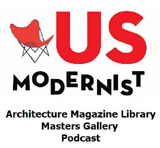
Today’s News - Thursday, April 27, 2017
EDITOR'S NOTE - Day 3: Something new - and improved. The Intro note "bullet" links to articles in the e-mailed newsletter were a bit difficult to target, so now the first few words are also highlighted. As always, the actual headlines with notable names called out still follow the Intro.
EDITOR'S NOTE Part Deux: Tomorrow and Monday are no-newsletter days. We'll be back Tuesday, May 2.
● ANN feature: Q&A with 2017 AIA Architecture Firm Award winners Bill Leddy, Marsha Maytum, and Richard Stacy on the eve of their award ceremony: "Our track record of pushing to make a difference shows that a small firm can make a difference."
● Wainwright parses how/why luxury-flat owners are trying to close the Tate's viewing platform: "It's part of a wider hijacking of cultural hotspots - relentlessly lobotomizing the cities they want to call home," and "ironing out the edgy 'vibrancy.'"
● Finch makes the case for why the Garden Bridge should be built: It's "a sophisticated folly" - when the number-crunchers and bureaucracy step in, "you know the drearies are in charge. Shame on them."
● Ritchie takes issue with Finch's "impassioned plea to let creatives be given free rein - the era of follies is over"; it's the "dishonest procurement process, lack of business plan, and misuse of public funds that is being attacked - not creativity."
● Harper explains why, "to confront populism, all architects should become classicists": "architects with any social conscience must wake up and smell the acanthus" - the Modernist agenda "damages our capacity to create much-needed public buildings."
● Moore considers Terry fils as he strikes out on his own: Francis "seems to have more fun" and is "less dogmatic. I find the reduction in dogma welcome" (he's no "Quinlan II" - "ho-ho birds" included).
● Lackmeyer parses Pei's c. 1960s legacy in Oklahoma City: "not many cities can boast of an entire downtown reshaped by the architect" - but many "who remember his legacy are generally pretty critical of his unfinished vision."
● Keats offers a most interesting take on visionary Soviet architecture and Trump's border wall: "Infrastructure can be powerful propaganda even when it isn't built - as long as the border wall remains on paper, there is ample opportunity for alternate visions."
● Eyefuls of the winners of the 2017 Architectural League Prize for Young Architects + Designers (an eclectic bunch!).
● Call for entries: UIA-HYP Cup 2017 International Student Competition.
Weekend diversions:
● Bozikovic cheers "Citizen Jane: Battle for the City" - a "gorgeous, tightly written and entertaining film."
● Wainwright cheers "Langlands & Bell: Infinite Loop" in London that "exposes the 'fantasy of total control' that is Silicon Valley architecture - as seen through detached, deadpan eyes."
● King says San Francisco can learn from Davidson's "Magnetic City: A Walking Companion to New York": "his impressions pertain to other prosperous cities in a perennial struggle between the future and the past."
● Q&A with Davidson re: "Magnetic City," his "atmospheric guide capturing the texture of urban life in print."
● Goldhagen's "Welcome to Your World: How the Built Environment Shapes Our Lives" gives "designers the language to communicate the importance of their trade - a task they've been attempting for centuries, but with little success."
● Brownell cheers Goldhagen's "Welcome to Your World": "Refreshingly, her condemnation eschews favoritism towards renowned architects. Rather, she focuses on what science tells us about good and bad design."
● Green gives Brownell's own "Transmaterial Next" two thumbs-ups for doing "a great job of explaining the environmental costs of our exploding resource use and how new, less wasteful materials will help."
● James-Chakraborty hails O'Toole's "One Hundred & One Hosannas for Architecture" that offers "some of the finest pieces of recent writing on Irish architecture" ("although I dread the many late night e-mails from my students on how to cite a book that lacks page numbers").
● O'Sullivan cheers the "delicious ambiguity" in O'Toole's new tome: "By highlighting what has been done he shows us what can be done, what should be done, and what is often not done."
● Coggan considers Andraos and Akawi's "The Arab City: Architecture and Representation" to be "an endlessly handsome volume of poetic dialogue about the region."
| |





|
|
|
To subscribe to the free daily newsletter
click here
|
ANN feature: 2017 AIA Architecture Firm Award Winners: An Interview with Bill Leddy, Marsha Maytum, and Richard Stacy of LEDDY MAYTUM STACY Architects: "Our track record of pushing to make a difference shows that a small firm can make a difference." - Marsha Maytum [images]- ArchNewsNow.com |
Oliver Wainwright: Gawpers go home: how luxury flat-owners [in Neo Bankside] could shut down the Tate's viewing platform: ...[thy] are taking the gallery to court, arguing its viewing platform invades their privacy. It’s part of a wider hijacking of cultural hotspots...relentlessly lobotomising the cities they want to call home, ironing out the edgy “vibrancy” on which they were sold their dream of urban living.- Guardian (UK) |
Paul Finch: Why the Garden Bridge should be built: The focus of some critics on procedure has become the enemy of creativity: ...the project is not a conventional bridge...but a sophisticated folly...The moment people with ideas are subjected to the grinding apparatus of...compulsory competition and 100-page form-filling, you know the drearies are in charge. Shame on them. -- Marks Barfield; Margaret Hodge; Thomas Heatherwick Studio- The Architects' Journal (UK) |
Ian Ritchie: The era of follies is over: The architect defends the critics of the Thames Garden Bridge proposal: In spite of Paul Finch’s impassioned plea to let creatives be given free rein...the "heart of the problem" [is] dishonest procurement process, lack of business plan, and misuse of public funds. This is what is being attacked by the [Hodge] report, the critics and the public - not creativity...The competition was a charade and all involved know it. -- Thomas Heatherwick- The Architects' Journal (UK) |
Phineas Harper: To confront populism, all architects should become classicists: If today's architects abandoned their modern vocabulary in favour of populist traditional or classical styles, they could achieve more progressive social goals: ...architects with any social conscience must wake up and smell the acanthus...Our stylistic reticence to even consider pre-modern sources damages our capacity to create much-needed public buildings.- Dezeen |
Rowan Moore: Francis Terry: "Architects tend to think if it’s popular, there’s something wrong": The neoclassical country piles designed by Quinlan Terry and his son Francis are adored by the royals and multimillionaires. Now Francis is striking out on his own: It’s tempting to cast the younger one as Quinlan II...[He] differs from his father in important respects. He seems to have more fun. He’s less dogmatic. He expresses doubt...I find the reduction in dogma welcome.- Observer (UK) |
Steve Lackmeyer: I.M. Pei legacy in Oklahoma City mixed on his 100th birthday: ...not many cities can boast of an entire downtown reshaped by the architect. OKC, however, hasn't boasted of Pei's work here in decades. Many of those who remember his legacy are generally pretty critical of his unfinished vision. [images]- The Oklahoman |
Jonathon Keats: Can Visionary Soviet Architecture Give Shape To Trump's Designs On American Infrastructure? "Imagine Moscow" at the Design Museum explores the ways in which this work of architecture-on-paper attained an oversized presence...without ever being built...Infrastructure can be powerful propaganda even when it isn't built...as long as the border wall remains on paper, there is ample opportunity for alternate visions...to topple the bigotry inherent in blockading assimilation.- Forbes |
Winners of the 2017 Architectural League Prize for Young Architects + Designers and dates for lectures & exhibition. -- Jonathan Louie/Nicole McIntosh/Architecture Office; Michelle JaJa Chang (Houston, TX); Kevin Hirth/KEVIN HIRTH Co.; Mustafa Faruki/theLab-lab for architecture; Isabel Martínez Abascal/Alessandro Arienzo/LANZA Atelier;; Greg Corso/Molly Hunker/SPORTS- Architectural League of New York |
Call for entries: UIA-HYP Cup 2017 International Student Competition: Architecture in Transformation - Transformation and Reconquest: What vitaland disruptive architectures can you come up with to transform the existingspaces of your choice? cash prizes; registration deadline: July 31 (submissions due August 31)- International Union of Architects (UIA)/School of Architecture, Tianjin University/Urban Environment Design Magazine (UED) |
Alex Bozikovic: "Citizen Jane: Battle for the City" elicits challenging discussion on urbanization: Matt Tyrnauer tells the tale of Jane Jacobs vs. Robert Moses well in this gorgeous, tightly written and entertaining film.- Globe and Mail (Canada) |
Oliver Wainwright: "Langlands & Bell: Infinite Loop": With their eerily pristine models of Apple and Facebook’s offices, [they] expose the "fantasy of total control" that is Silicon Valley architecture: These bleached bodies are the headquarters buildings of the world’s biggest technology companies, as seen through the detached, deadpan eyes...at Alan Cristea Gallery, London [images]- Guardian (UK) |
John King: SF can learn from new book on ‘Magnetic’ New York: Anyone who knows and cares about a city like San Francisco carries fragments of the city that are gone....“Magnetic City: A Walking Companion to New York" by Justin Davidson...his impressions resonate much further, and they pertain to other prosperous cities in a perennial struggle between the future and the past.- San Francisco Chronicle |
Justin Davidson discusses "Magnetic City: A Walking Companion to New York," his walking guide to New York’s architecture and history: ...his atmospheric guide...capturing the texture of urban life in print..."one central aspect of the urban experience...that sense that the past and the present and the future are all intertwined."- NY Newsday |
Feeling Sad? Blame the Building: ...Sarah Williams Goldhagen sets out to quantify how the built environment affects our lives: "Welcome to Your World: How the Built Environment Shapes Our Lives" pulls from new research in psychology and neuroscience...gives designers the language to communicate the importance of their trade - a task they’ve been attempting for centuries, but with little success.- Surface magazine |
Blaine Brownell: Assessing Architecture Through Neuroscience and Psychology: "Welcome to Your World: How the Built Environment Shapes Our Lives" by Sarah Williams Goldhagen: Refreshingly, the expansive sweep of her condemnation eschews favoritism towards...renowned architects or vernacular builders. Rather, she focuses on what science tells us about good and bad design...- Architect Magazine |
Jared Green: Future Materials Here Today: Self-Healing Concrete, Biological Bricks, and More: ...Blaine Brownell in his excellent new book "Transmaterial Next: A Catalog of Materials That Define Our Future"...does a great job of explaining the environmental costs of our exploding resource use and how new, less wasteful materials will help.- The Dirt/American Society of Landscape Architects (ASLA) |
Kathleen James-Chakraborty: Our exquisite recent Architecture: Even if most of the recent legacy is subpar: "One Hundred & One Hosannas for Architecture"...by Shane O’Toole, Ireland’s most celebrated critic of the island’s contemporary architecture...eloquent prose...His appreciations of the pioneering Irish modernism...are some of the finest pieces of recent writing on Irish architecture. -- Group 91 [images]- Village Magazine (Dublin, Ireland) |
Des O’Sullivan: Vintage view: Shane O'Toole's new collection of writing from 1999-2016: A delicious ambiguity is contained in the title "One Hundred & One Hosannas for Architecture." ...is it a hymn of praise or a plea for salvation? Anything that focuses Irish minds on architecture is always welcome...By highlighting what has been done he shows us what can be done, what should be done, and what is often not done.- Irish Examiner |
Annie Coggan: "The Arab City: Architecture and Representation" edited by Amale Andraos and Nora Akawi: ...26 essays discussing not just the state of Arab architecture but the state of architecture in an endlessly fluid political landscape...an endlessly handsome volume of poetic dialogue about the region.- AIANY/Center for Architecture Newsletter (formerly e-Oculus) |

|
Kirsten Kiser: Dominique Perrault: New Mechanics Hall - ME Building, Lausanne, Switzerland: Science is the essence of the ME building...a new milestone in the history of the EPFL (École Polytechnique Fédérale de Lausanne) campus...serves as a large-scale experimental playground and laboratory for research scientists... -- Zweifel + Stricker + Associates (1970s) [images] |
|
|
Note: Pages will open in a new browser window.
External news links are not endorsed by ArchNewsNow.com.
Free registration may be required on some sites.
Some pages may expire after a few days.
© 2017 ArchNewsNow.com

